.
FRANCE 2012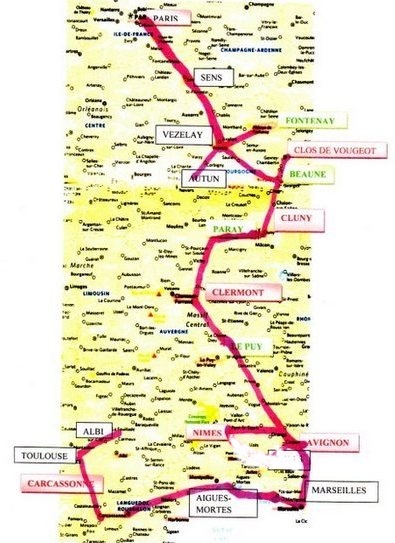
Day 21 Saturday, September 23
Albi
It is hard to believe that we have been gone three weeks
today. It has gone by very quickly, yet feels like we have been away
from home a long, long time. We will be happy to see all of our family
and our little Jeremiah. Tomorrow is our last day. Our plane leaves at
8:30 am on Tuesday.
Each morning it is harder and harder to get up. We managed get to
the breakfast room before they closed. As
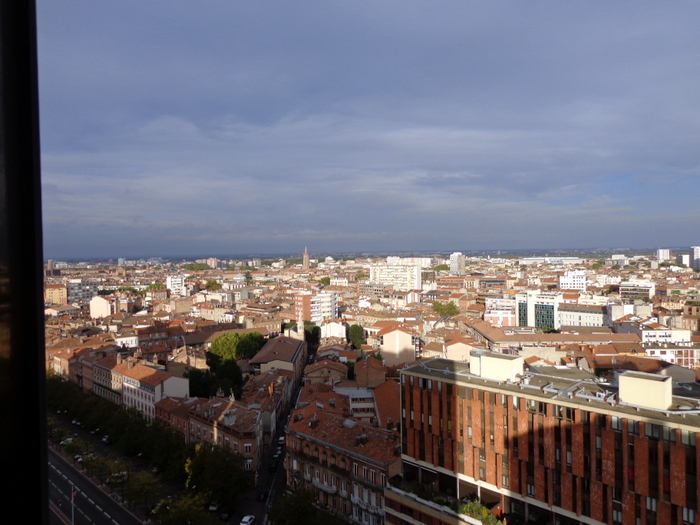 we
had planned, we left for Albi right after breakfast. Albi is an hour
drive north west of here.
we
had planned, we left for Albi right after breakfast. Albi is an hour
drive north west of here.
The photo on the left is from our hotel room. The distant tall
steeple is St. Sernin that we visited yesterday.
Albi is a very old city with all of its buildings built out of
pink brick from clay from the Tarn River. In the 12c-13c, the crusades
against the Cathars became known as the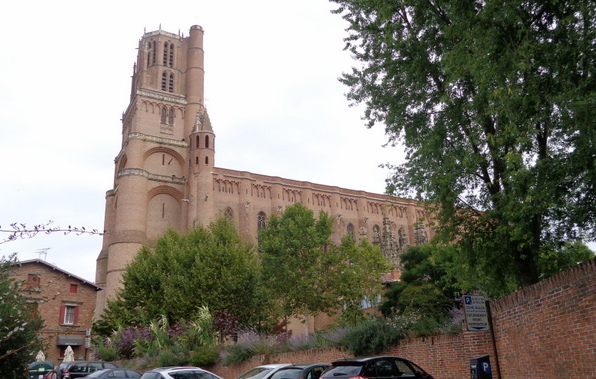 Albigensian Crusades. See more information about the Cathars on
Day 18
Albigensian Crusades. See more information about the Cathars on
Day 18
One of the most remarkable structures in France is the
St.
Cecile’s Cathedral in Albi. From the outside it resembles a for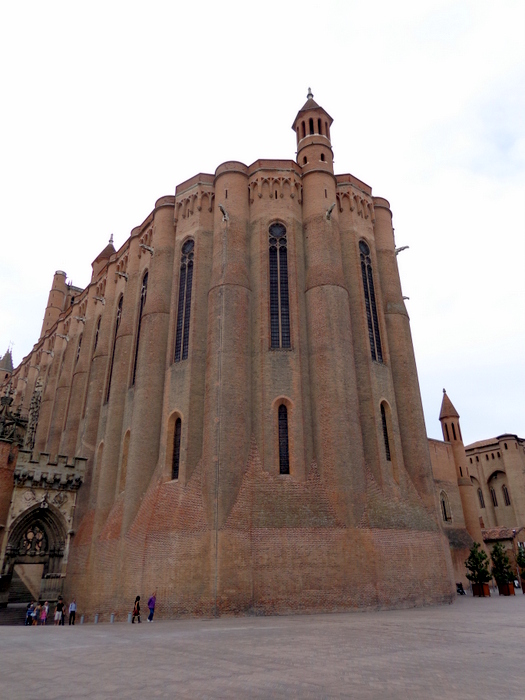 tress
with very high walls and narrow long windows. The structure is almost
overwhelming. The first stone was set in place in 1282 by Bishop Bernard
de Castanet with the completion of the foundation work in 1383. He
intended the Cathedral to proclaim the supreme grandeur of God, the
solidity of the Christian faith and the rigidity of Orthodox belief in
the face Catharism (or the heretic Albigensians) which was not entirely
eradicated. The church built of pink and red bricks and is 370
feet long, hundred and 114 feet wide, with walls 131 feet tall and
a Bell tower measuring 256 feet.
tress
with very high walls and narrow long windows. The structure is almost
overwhelming. The first stone was set in place in 1282 by Bishop Bernard
de Castanet with the completion of the foundation work in 1383. He
intended the Cathedral to proclaim the supreme grandeur of God, the
solidity of the Christian faith and the rigidity of Orthodox belief in
the face Catharism (or the heretic Albigensians) which was not entirely
eradicated. The church built of pink and red bricks and is 370
feet long, hundred and 114 feet wide, with walls 131 feet tall and
a Bell tower measuring 256 feet.
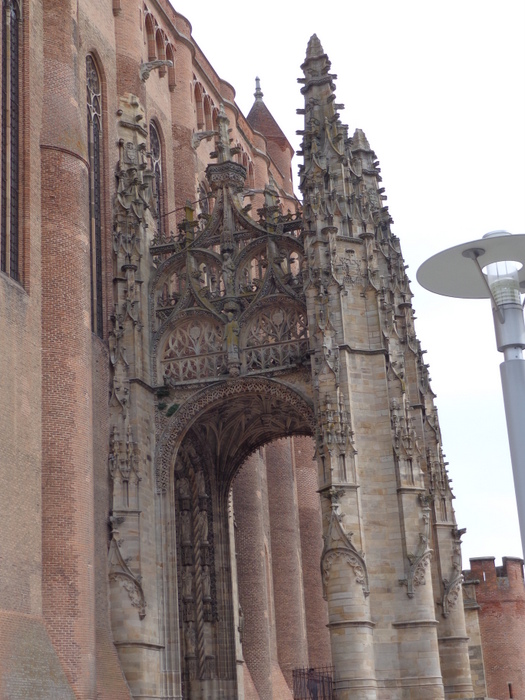
At the entrance is a large ornate baldachin. This is the first time
that I have seen a baldachin on the outside of a church. We have been in
several churches where there is a baldachin over the altar, the most
notable being St. Peter's in Rome. The St. Cecile's baldachin has
ornamental stonework of pinnacles, intertwining arches, and flamboyant
ribbing on the three sides. It was completed in 1535. The main entrance
to the Basilica is through the baldachin which is on the south side.
There is no front or West side entrance.
T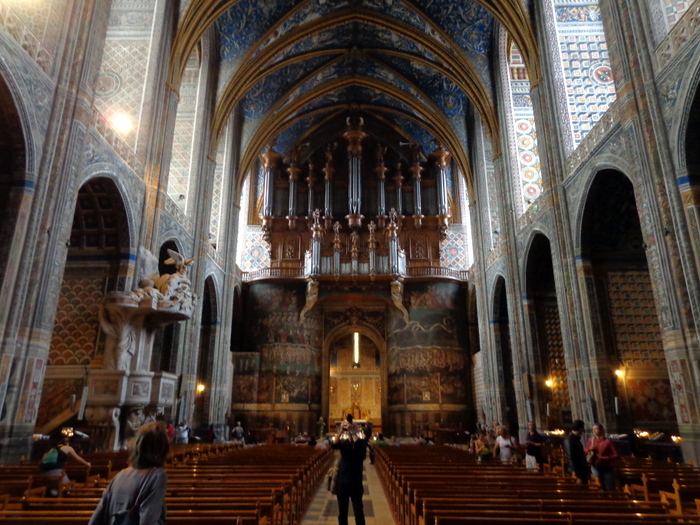 he
inside is extremely beautiful. It is the only cathedral in France where
everything is painted – much of it like the ceiling has not be touched
in 500 years. Most cathedrals were built with a screen across between
the choir and the nave of the church known as a rood screen. The choir
and sanctuary and altar were closed off from the rest of the
congregation and because of the large number of clergy who had many
daily services and this gave them privacy.
he
inside is extremely beautiful. It is the only cathedral in France where
everything is painted – much of it like the ceiling has not be touched
in 500 years. Most cathedrals were built with a screen across between
the choir and the nave of the church known as a rood screen. The choir
and sanctuary and altar were closed off from the rest of the
congregation and because of the large number of clergy who had many
daily services and this gave them privacy.
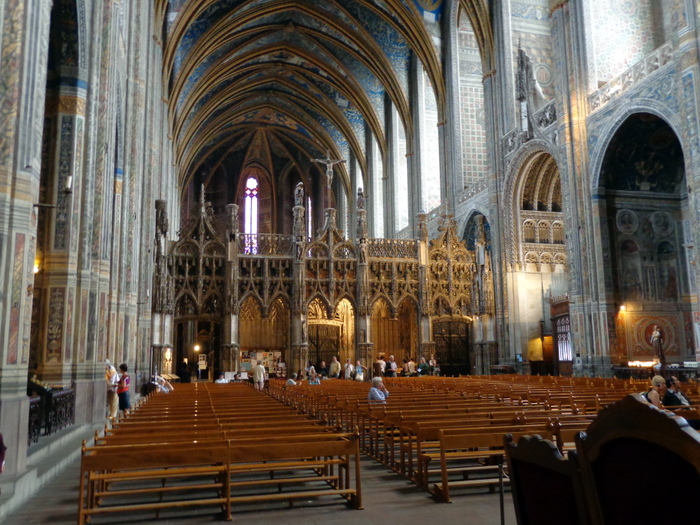 Often
there was central door leading to the nave. Most cathedrals have
removed this screen so that those sitting in the congregation can see
and participate in the service. Several cathedrals and Abbeys that we
have visited have not removed this screen – Canterbury and Westminster
Abbey to name two. Washington Cathedral has one but it is open so you
can see the altar from the nave. Because of the elaborate stone
carvings on the rood screen at St. Cecile’s it has not been removed.
Often
there was central door leading to the nave. Most cathedrals have
removed this screen so that those sitting in the congregation can see
and participate in the service. Several cathedrals and Abbeys that we
have visited have not removed this screen – Canterbury and Westminster
Abbey to name two. Washington Cathedral has one but it is open so you
can see the altar from the nave. Because of the elaborate stone
carvings on the rood screen at St. Cecile’s it has not been removed.
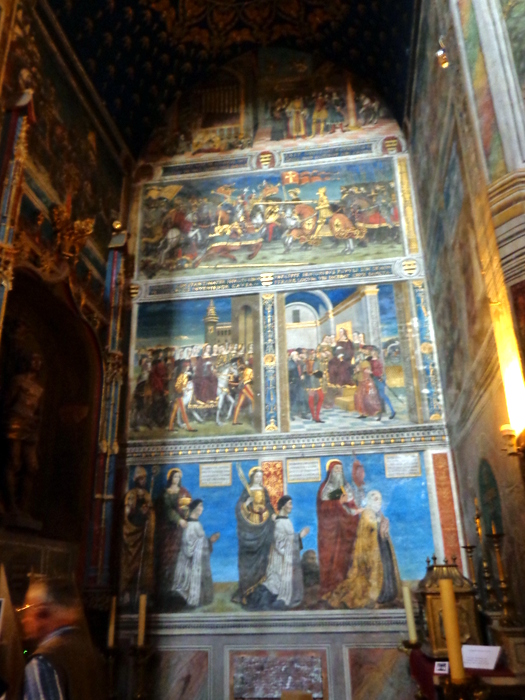
The nave which is beautifully painted, is flanked by 29
chapels an example on the left.
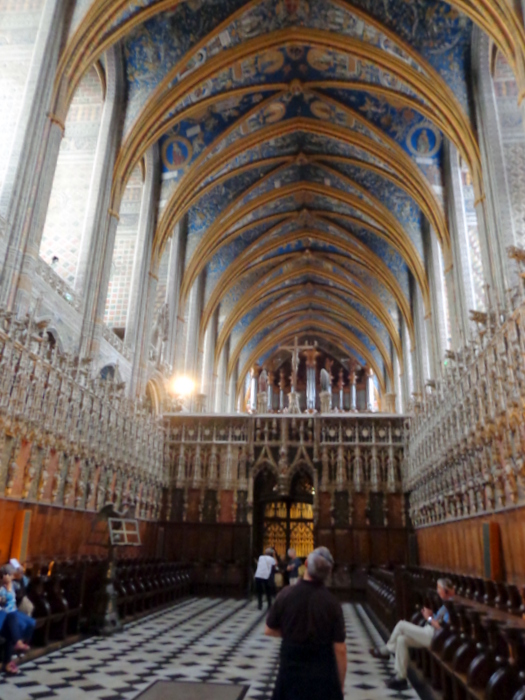
The great choir has gold and azure , the scrolls, and coats of arms
and the figures of cherubins of the vaulting.
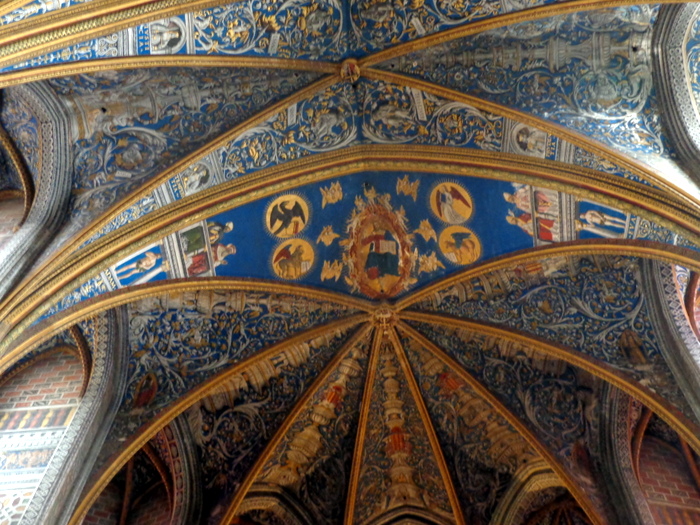
The vaulting of the entire church is an enormous fresco of
color and light and is the largest in the world Italian painters from
Bologna executed it in record time from 1509 to 1512. It has never been
retouched.
We had audio guides in English so we spent a long time at St.
Cecile.
It was about 3:00 when we left, and we hadn’t had lunch.
There were several cafes across the street so picked one and we each had
croque monsieur and salad for lunch.
The other thing that Albi is famous for is Henri de
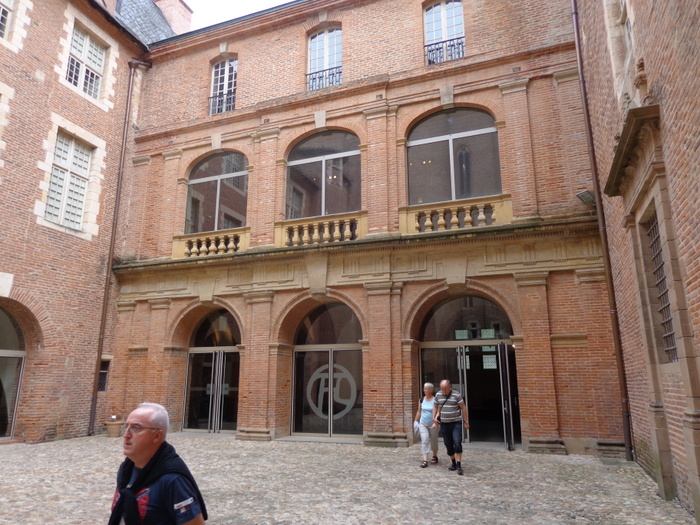 Toulouse-Lautrec.
He was born there in 1864 into a wealthy family but an early childhood
accident left him crippled for life. In 1882 he moved to Montmartre in
Paris where he did most of his painting. There is a large
Toulouse-Lautrec Art Museum in the old Bishop’s Palace in Albi. We
spent an hour or so looking at various painting of Toulouse-Lautrec.
Toulouse-Lautrec.
He was born there in 1864 into a wealthy family but an early childhood
accident left him crippled for life. In 1882 he moved to Montmartre in
Paris where he did most of his painting. There is a large
Toulouse-Lautrec Art Museum in the old Bishop’s Palace in Albi. We
spent an hour or so looking at various painting of Toulouse-Lautrec.
We found our way out of town – thanks to our faithful TomTom and got
back to our apartment about 6:00. We were not hungry, but we went back
to the hotel dining room where we ate last night and had a light
supper. Kathleen had carrot soup, and I had a salad with chicken
slices. It was just enough. One of the things we dislike about eating
in France is that it takes forever to get the check. There were only
four other tables being served and we waited almost a half hour for our
check.

 we
had planned, we left for Albi right after breakfast. Albi is an hour
drive north west of here.
we
had planned, we left for Albi right after breakfast. Albi is an hour
drive north west of here.  Albigensian Crusades. See more information about the Cathars on
Day 18
Albigensian Crusades. See more information about the Cathars on
Day 18 tress
with very high walls and narrow long windows. The structure is almost
overwhelming. The first stone was set in place in 1282 by Bishop Bernard
de Castanet with the completion of the foundation work in 1383. He
intended the Cathedral to proclaim the supreme grandeur of God, the
solidity of the Christian faith and the rigidity of Orthodox belief in
the face Catharism (or the heretic Albigensians) which was not entirely
eradicated. The church built of pink and red bricks and is 370
feet long, hundred and 114 feet wide, with walls 131 feet tall and
a Bell tower measuring 256 feet.
tress
with very high walls and narrow long windows. The structure is almost
overwhelming. The first stone was set in place in 1282 by Bishop Bernard
de Castanet with the completion of the foundation work in 1383. He
intended the Cathedral to proclaim the supreme grandeur of God, the
solidity of the Christian faith and the rigidity of Orthodox belief in
the face Catharism (or the heretic Albigensians) which was not entirely
eradicated. The church built of pink and red bricks and is 370
feet long, hundred and 114 feet wide, with walls 131 feet tall and
a Bell tower measuring 256 feet.  he
inside is extremely beautiful. It is the only cathedral in France where
everything is painted – much of it like the ceiling has not be touched
in 500 years. Most cathedrals were built with a screen across between
the choir and the nave of the church known as a rood screen. The choir
and sanctuary and altar were closed off from the rest of the
congregation and because of the large number of clergy who had many
daily services and this gave them privacy.
he
inside is extremely beautiful. It is the only cathedral in France where
everything is painted – much of it like the ceiling has not be touched
in 500 years. Most cathedrals were built with a screen across between
the choir and the nave of the church known as a rood screen. The choir
and sanctuary and altar were closed off from the rest of the
congregation and because of the large number of clergy who had many
daily services and this gave them privacy.
 Often
there was central door leading to the nave. Most cathedrals have
removed this screen so that those sitting in the congregation can see
and participate in the service. Several cathedrals and Abbeys that we
have visited have not removed this screen – Canterbury and Westminster
Abbey to name two. Washington Cathedral has one but it is open so you
can see the altar from the nave. Because of the elaborate stone
carvings on the rood screen at St. Cecile’s it has not been removed.
Often
there was central door leading to the nave. Most cathedrals have
removed this screen so that those sitting in the congregation can see
and participate in the service. Several cathedrals and Abbeys that we
have visited have not removed this screen – Canterbury and Westminster
Abbey to name two. Washington Cathedral has one but it is open so you
can see the altar from the nave. Because of the elaborate stone
carvings on the rood screen at St. Cecile’s it has not been removed.

 Toulouse-Lautrec.
He was born there in 1864 into a wealthy family but an early childhood
accident left him crippled for life. In 1882 he moved to Montmartre in
Paris where he did most of his painting. There is a large
Toulouse-Lautrec Art Museum in the old Bishop’s Palace in Albi. We
spent an hour or so looking at various painting of Toulouse-Lautrec.
Toulouse-Lautrec.
He was born there in 1864 into a wealthy family but an early childhood
accident left him crippled for life. In 1882 he moved to Montmartre in
Paris where he did most of his painting. There is a large
Toulouse-Lautrec Art Museum in the old Bishop’s Palace in Albi. We
spent an hour or so looking at various painting of Toulouse-Lautrec.
